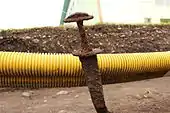Salme ships
The Salme ships are two clinker-built ships of Scandinavian origin discovered in 2008 and 2010 near the village of Salme on the island of Saaremaa, Estonia. Both ships were used for ship burials here around AD 700–750 in the Nordic Iron Age and contained the remains of more than 40 warriors killed in battle, as well as numerous weapons and other artifacts.[1]
Discovery and excavation

The first ship was discovered in 2008 during earth removal for infrastructure construction. An archaeological expedition has been working on site since 2008. The second ship was discovered in 2010. It is possible that at least one more ship is yet to be discovered during future excavations.
Location
The ships were located near the ancient coastline, about 1.5 metres (5 ft) above water level. The location is 230 metres (250 yd) from the present coastline and 4 metres (13 ft) above present water level.[2]
Description
Both Salme ships are clinker-built and archaeologists have estimated their time of construction to be AD 650–700 in Scandinavia. There are signs indicating they had been repaired and patched for decades before making their final voyage. One of the ships is 11.5 metres (38 ft) long and 2 metres (7 ft) wide, the second one more than 17 metres (56 ft) long and 3 metres (10 ft) wide. None of them had mast or sails, and they would have been rowed for short distances along the Baltic coast, or between islands,[3] or straight across the Baltic, as rowing longer distances has proved perfectly feasible time and again in modern times. This is also indicated by the Old Norse word for distance across water "vikusjö, vikja" the distance to row before changing rowers, a distance of about 4.2 nautical miles (7.8 km; 4.8 mi).
Human remains
Skeletal remains from at least 42 individuals were discovered in the two ships.[4] Most of them belonged to 30–40 year old males who had been killed in battle.[5][6] Isotope analysis of some of the teeth, combined with the design of the buried artifacts, suggest that the men came from central Sweden.[7] The smaller ship contained the skeletal remains of 7 individuals. There were at least 36 individuals buried in four layers in the large ship.[8] In samples from the VII century Salme defined Y-chromosome haplogroup R1a1a1b, N1a1a1a1a1a1a, I1-M253 and mtDNA haplogroup T2b5a, V, J2a1a1a2, H10e, K1c1h, W6a, U3b1b.[9] The DNA analysis showed that four of the men were brothers and they were related to a fifth man, perhaps an uncle.[10]
Grave goods

Fragments of more than 40 swords of various types, remains of shields, spearheads and dozens of arrowheads were found in the burial. Most of them had been deliberately deformed, perhaps to discourage grave robbery.
Smaller objects included one small socketed axe, knives, whetstones, a bone comb with ornaments, a bear-claw necklace, and hundreds of gaming pieces made of whale bone and antler with six dice.
The skeletal remains of two ritually sacrificed dogs as well as hawks used for falconry were found in the burial.
Interpretations
According to an early interpretation offered by Jüri Peets, the lead archaeologist at the site, the ships and the dead are of Scandinavian origin. According to the most likely scenario, a war party of Scandinavians attempted to carry out a raid against the Oeselians (Estonian inhabitants of the island of Saaremaa), but were attacked by Oeselian ships. The sides of the two ships contain numerous embedded arrowheads, some of which are of the three-pointed type used to carry burning materials to set enemy ships aflame. After losing too many oarsmen to the Estonian archers, the raiders pulled their ships aground and tried to defend themselves behind them. It appears that after the battle, the Oeselians allowed either the survivors or some other group of Scandinavians to ritually bury their dead. The burial is unusual because the ships were not covered with earth mounds. The site was eventually forgotten by the local inhabitants after it had become overblown by sand and covered with vegetation.[11] The raid-hypothesis has led to a questioning of when the Viking Age began exactly. The Salme event took place 50–100 years earlier than the infamous Lindisfarne Viking raid in England in the summer of AD 793.[12]
The original interpretation was called into question after the second, larger, ship was uncovered in 2010. It is likely that the human remains in it belonged to individuals of noble birth, as evidenced by the large number of expensive bronze sword-hilts and the complete lack of weaponry associated with commoners. The presence of dogs and hawks used for falconry indicates that the original purpose of the trip to Estonia may have been leisure or diplomacy.[13] Peets suggests that the men may have come on a voyage from Sweden to forge an alliance or establish kinship ties when unknown parties set upon them.[14]
Legendary background
Snorri Sturluson relates in his Ynglinga saga that the Swedish king Ingvar, Östen's son, was a great warrior who often spent time patrolling the shores of his kingdom fighting Danes and Vikings from Estonia (Víkingr frá Esthland). King Ingvar finally came to a peace agreement with the Danes and could take care of the Vikings in Estonia. He consequently started pillaging in Estonia in retribution, and one summer he arrived at a place called Stein (see also Sveigder). The Vikings in Estonia (sýslu kind) assembled a great army in the interior and attacked King Ingvar in a great battle. Their forces were too powerful and Ingvar fell and the Swedish forces retreated. Ingvar was buried in a mound at a place called Stone or Hill fort (at Steini) on the shores of Aðalsýsla, that is what is now mainland Estonia.
References
- Mägi, M. (2018). In Austrvegr: The Role of the Eastern Baltic in Viking Age Communication across the Baltic Sea. The Northern World. Brill. p. 233. ISBN 978-90-04-36381-6. Retrieved 24 August 2018.
The first real ship-graves in the Eastern Baltic were excavated in 2008–2011 at Salme on the island of Saaremaa. The location near a probable, but hitherto not found harbour place at a one-time narrow strait ...
- The Salme shipfind blog
- Archaeology: The First Vikings
- Marek Strandberg. "Arheoloog: Eesti ala elanikud surid 536. aasta paiku massiliselt nälga". Postimees 17. märts 2013. (in Estonian)
- Scandinavians were defeated in a battle in Saaremaa (in Estonian)
- Salme muinaslaevast leiti haruldane luukamm (fotod). Saarte Hääl, 26 Jul 2011.(in Estonian)
- Ancient ships of death: Were they on a mission of politics or plunder? USA Today. 27 July 2016. Retrieved 27 July 2016.
- Arheoloogia-aasta parimad palad. Postimees, 17 Oct 2011. (in Estonian)
- Ashot Margaryan et al. Population genomics of the Viking world, 2020 (bioRxiv)
- The Vikings Were More Complicated Than You Might Think, Sept. 16, 2020
- Scandinavians were defeated in a battle in Saaremaa (in Estonian)
- Archaeology: The First Vikings
- Arheoloogia-aasta parimad palad. Postimees, 17 Oct 2011. (in Estonian)
- Ancient ships of death: Were they on a mission of politics or plunder? USA Today. 27 July 2016. Retrieved 27 July 2016.
Sources
- Andrew Curry (10 June 2013). "The First Vikings". Archaeology. the Archaeological Institute of America. Retrieved 22 February 2014.
External links
| Wikimedia Commons has media related to Salme shipfind. |
- 22. March 2013, CWA 58, Archaeologists in Estonia have discovered the most extraordinary site: a mass grave comprising two Viking ship burials, world-archaeology.com
- 10. June 2013, The First Vikings/ Two remarkable ships may show that the Viking storm was brewing long before their assault on England and the continent, archaeology.org
